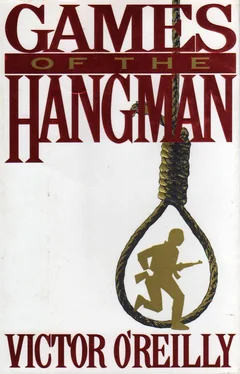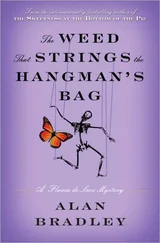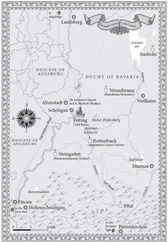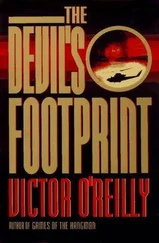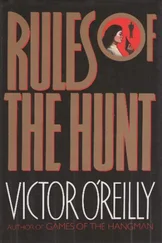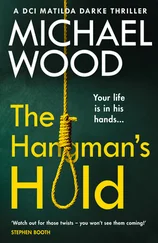Victor O'Reilly - Games of The Hangman
Здесь есть возможность читать онлайн «Victor O'Reilly - Games of The Hangman» весь текст электронной книги совершенно бесплатно (целиком полную версию без сокращений). В некоторых случаях можно слушать аудио, скачать через торрент в формате fb2 и присутствует краткое содержание. Жанр: Триллер, на английском языке. Описание произведения, (предисловие) а так же отзывы посетителей доступны на портале библиотеки ЛибКат.
- Название:Games of The Hangman
- Автор:
- Жанр:
- Год:неизвестен
- ISBN:нет данных
- Рейтинг книги:4 / 5. Голосов: 1
-
Избранное:Добавить в избранное
- Отзывы:
-
Ваша оценка:
- 80
- 1
- 2
- 3
- 4
- 5
Games of The Hangman: краткое содержание, описание и аннотация
Предлагаем к чтению аннотацию, описание, краткое содержание или предисловие (зависит от того, что написал сам автор книги «Games of The Hangman»). Если вы не нашли необходимую информацию о книге — напишите в комментариях, мы постараемся отыскать её.
Games of The Hangman — читать онлайн бесплатно полную книгу (весь текст) целиком
Ниже представлен текст книги, разбитый по страницам. Система сохранения места последней прочитанной страницы, позволяет с удобством читать онлайн бесплатно книгу «Games of The Hangman», без необходимости каждый раз заново искать на чём Вы остановились. Поставьте закладку, и сможете в любой момент перейти на страницу, на которой закончили чтение.
Интервал:
Закладка:
For five days and nights they saw nothing unusual, but on the sixth night their strained patience was rewarded. The video had been shot using a zoom lens and a second-generation image intensifier. It had been raining heavily at the time, so detail was not good, though it was reasonable given the conditions. Nevertheless, what the observation team had photographed was startling enough.
Shortly after midnight, with one more night of long and monotonous observation to go, a single figure was seen slipping out of the side entrance of the college. The image was scarcely more than a blurred silhouette at first, since the camera lens was set at normal pending a specific target. The figure reached the cover of some gorse bushes and crouched down, blending into the surroundings. One disadvantage of the image intensifier was its inability to show colors; everything showed up in contrasting shades of greenish gray.
The camera operator began to zoon in to get a closer look with the powerful telephoto lens but then paused to pull back slightly to cover two more figures, who left the side entrance and ran, crouched down, to cover. There was a wait of perhaps half a minute before two more figures appeared. Several minutes passed. The camera zoomed in to try to get a close-up, but the bushes were in the way, and only small glimpses of human forms through the gaps in the foliage indicated that they were still there.
Kilmara imagined what it was like for the Rangers waiting in the blinds. Holes had been dug in the ground, making use of any natural features that could be turned to the diggers' advantage, such as an overhang to prevent observation from the air or a fold in the ground to hide the entrance. The top sods had been removed intact, and the undersoil dug out carefully and concealed. The holes were covered with a frame of reinforced chicken wire, which in turn was surfaced with the original sods to match the surrounding terrain. The result could be stood upon without detection and would be virtually invisible from even a few yards away.
Routine observation was kept through a miniature lens mounted at the end of a fiber-optic cable that would peer periscope style through the roof of the blind. The incoming pictures could be monitored on a pocket-size television. The technology had been adapted from that used in microsurgery.
The first figure emerged from behind the clump of bushes, followed at twenty yard intervals by the others. In single file they headed for the wood. The picture on the screen dissolved into an out-of-focus blur for a few seconds before sharpening again into close-up. Kilmara felt the same shock that had struck him at the first viewing. The face on the screen was not human. He was looking at the body of a man and the head of some monstrous, unrecognizable animal: fur and matted hair, short, curving horns, a protruding muzzle fixed in a snarl. It was an image from a nightmare.
The camera surveyed each figure in turn. Each wore a different and equally bizarre mask. They vanished into the wood.
"Two suicides by hanging and the accidental death of the headmaster," said Gunther, "and now this?"
"Well, at least we now have a pretty fair idea of what happened to Fitzduane's goat," said Kilmara, "but dressing up isn't a crime."
"So you think all is in order?"
"Do pigs fly?"
The camp was more than two hundred kilometers south of Tripoli and had been built around a small oasis, its date palms and patch of dusty greenery now submerged in a forest of prefabricated single-story barracks, concrete blockhouses, weapons ranges, parade grounds, and assault courses.
Two four-meter-high barbed-wire fences secured the perimeter. The outer fence had been electrified, and watchtowers equipped with KPV 14.5 mm Vladimorov heavy machine guns were placed at two-hundred-meter intervals. Missile batteries augmented with mobile radar-guided four-barreled ZSU-4 antiaircraft guns guarded the approaches.
The cam could hold as many as a thousand trainee freedom fighters, and over the years since its construction many times that number of members of the PLO, the Polisario, and the myriad other violent groups supported by Colonel Muammar Qaddafi had passed through its gates.
Slightly depleted by a steady drain of fatal casualties experienced in live-ammunition training, they emerged after intensive indoctrination in guerrilla tactics and terrorist techniques, including refinements such as constructing car and letter bombs, concealing weapons and explosives aboard aircraft, getting the maximum media reaction from a terrorist incident, torture, and the handling and execution of hostages. The instructors were proficient, experienced, and impersonal. They lived apart from their trainees in luxury air-conditioned accommodations outside the camp. The languages heard around their Olympic-size swimming pool amid the clinking of glasses, the laughter, and the splashing were those of East Germany, Cuba, and Russia.
There were other such camps in Libya and indeed in South Yemen, Cuba, Syria, Lebanon, East Germany, and Russia. Camp Carlos Marighella, named after the Brazilian author of one of the most famous urban terrorism handbooks, had been chosen because it was isolated and secure, and the project had the personal support of Muammar Qaddafi.
Since he overthrew Libya's senile King Idris in 1969, Qaddafi had provided money, arms, sanctuary, and training facilities for just about every terrorist organization worthy of the name. He had provided active support for the team that carried out the Olympic Games massacre in Munich. He had provided the PLO with a yearly allowance of forty million dollars. He had offered a million dollars for the assassination of Anwar Sadat of Egypt. He had invaded Tunisia. He had fought with Egypt. He had repeatedly invaded Chad. He had fomented unrest in the Sudan. He had given financial assistance to the Nicaraguan Sandinistas, Argentina's Montoneros, Uruguay's Tupamaros, the IRA Provisionals, the Spanish Basque ETA, the French Breton and Corsican separatist movements, and Muslim insurgents in Thailand, Indonesia, Malaysia, and the Philippines. He had provided military assistance to Emperor Bokassa of the Central African Republic and Idi Main of Uganda. He had been behind the blowing up of a Pan American plane at Rome's FiumicinoAirport, in which thirty-one passengers burned to death. He had provided the SAM-7 heat-seeking missiles with which a Palestinian team planned to shoot down an El Al jet taking off from Fiumicino. He had been an active supporter of the OPEC raid in Vienna in Christmas 1975.
The man who had selected Libya as the training ground and marshaling area for his assault group felt quite satisfied that he had made the right decision. His every need was being met. Qaddafi had even offered a bonus of ten million dollars upon successful completion of the project. At the end of their private audience he had presented the man with a personally autographed copy of his Green Book on the Islamic Revolution – and a check for half a million dollars toward initial expenses.
In Libya the man was known as Felix Kadar. It was a name of no particular significance; in other countries he was known by other names. In the files of the CIA and the U.S. State Department's Office to Combat Terrorism he was known only by the code name Scimitar. The man had no particular political views or commitments to any specific ideology. He had been baptized a Catholic, but on occasion he wore the green turban that signified the pilgrimage to Mecca. He had indeed gone there. He had been one of the planners of the assault on the Great Mosque and had been agreeably surprised by the inability of Saudi Arabia's own forces to dislodge the intruders. In the end, the assistance of the French government was called for: the Gigene, the highly specialized National Gendarmerie Intervention Group, came on the scene – and the raiders died, leaving the Saudi royal family much shaken and the man in the green turban one million dollars richer.
Читать дальшеИнтервал:
Закладка:
Похожие книги на «Games of The Hangman»
Представляем Вашему вниманию похожие книги на «Games of The Hangman» списком для выбора. Мы отобрали схожую по названию и смыслу литературу в надежде предоставить читателям больше вариантов отыскать новые, интересные, ещё непрочитанные произведения.
Обсуждение, отзывы о книге «Games of The Hangman» и просто собственные мнения читателей. Оставьте ваши комментарии, напишите, что Вы думаете о произведении, его смысле или главных героях. Укажите что конкретно понравилось, а что нет, и почему Вы так считаете.
